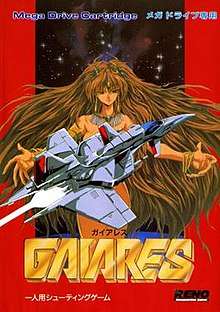Gaiares
Gaiares (ガイアレス, Gaiaresu) is a horizontally scrolling shooter developed by Telenet Japan and published by Renovation for the Sega Genesis in Japan and North America in 1990. It was one of the first 8Mb cartridge games on the Genesis. Its title combined Gaia (Mother Earth) and the suffix "less" (Res), as the Earth has been lost to pollution in the far future according to the game's plot (thus making mankind "Earthless").[1]
| Gaiares | |
|---|---|
 Japanese Mega Drive cover art showing Dan Dare's starfighter and the alien Queen of Leezaluth | |
| Developer(s) | Telenet Japan |
| Publisher(s) | Renovation |
| Designer(s) | Kōji Yokota Masayasu Yamamoto |
| Composer(s) | Shinobu Ogawa Minoru Yuasa |
| Platform(s) | Sega Genesis |
| Release | |
| Genre(s) | Scrolling shooter |
| Mode(s) | Single-player |
Plot
In the year 3000 Earth has become a toxic dump ravaged by careless humans, leaving an uninhabitable, polluted wasteland. The powerful alien space pirates Gulfer, led by the evil Queen ZZ Badnusty, plan to harvest the pollution to create weapons of mass destruction. The United Star Cluster of Leezaluth sent a warning to Earth about their plans, stating that if they could not stop them, Leezaluth would be forced to supernova Earth's sun to avoid war with Gulfer; but if humans succeeded, Leezaluth would use their technology to restore Earth to its former beauty.
Legendary space hero Dan Dare (Diaz in the Japanese original), a young but brave and very skilled ace pilot from Earth was chosen to be the pilot of a new starfighter to combat Gulfer. The ship is armed with a powerful experimental weapon from Leezaluth called the TOZ System, which would be operated by Alexis, an alien princess from Leezaluth and Dan's lover.
Gameplay
Most horizontal shooters require the player's ship to come in contact with a capsule to gain weapons. The Gaiares design was different, and features one of the most original and unique weapon power-up systems in the shooters genre to date. The TOZ System device can be fired out like the R-Type's Force, except each time it comes in contact with an enemy, it would inherit and learn its weapon; the player can steal from the same enemy repeatedly until the weapon's strength is maxed out. There are 18 weapons in total to be captured, and the appearance of each weapon varies depending on the strength meter.
Many of the stage designs were heavily influenced by Macross, Gradius, and Valis, though some deviation is apparent with bosses like Death Ghetto and Mermaid. Gaiares makes extensive use of parallax scrolling, wave and warping effects across all eight stages. The bosses are mostly screen-sized. The game is notorious for its high difficulty level.
Reception
| Reception | ||||||||||
|---|---|---|---|---|---|---|---|---|---|---|
| ||||||||||
Gaiares was very well received. MegaTech opined it was "an excellent looking game, but by far the toughest horizontally scrolling shoot 'em up available on the Mega Drive".[5] It was the first game to receive perfect scores in every category in GamePro.[6]
A 2002 review by Game Informer called it "a shooter masterpiece" and "perhaps the greatest of all horizontally scrolling 2D shooters."[2] A 2008 retrospective review by IGN called it "an excellent shooter that has aged quite well since the sunset of the Genesis."[3]
References
- Sczepaniak, John (2016-01-25). "Gaiares – Hardcore Gaming 101". Hardcore Gaming 101. Retrieved 2020-05-28.
- "Classic Reviews: Gaiares". Game Informer. 12 (112): 108. August 2002.
- "Gaiares Review - IGN". Uk.ign.com. 2008-05-14. Retrieved 2016-07-29.
- MegaTech, EMAP. Issue 6, page 78 (June 1992).
- "Out-of-Print Archive • Mega Drive reviews • Gaiares". Outofprintarchive.com. Retrieved 2016-07-29.
- "The Magazine Biz". GamePro. No. 100. IDG. January 1997. pp. 24–25.